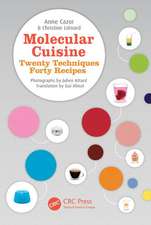New Methods of Food Preservation
Autor G. W. Goulden Limba Engleză Paperback – 20 oct 2012
Preț: 391.02 lei
Nou
Puncte Express: 587
Preț estimativ în valută:
74.85€ • 81.33$ • 62.91£
74.85€ • 81.33$ • 62.91£
Carte tipărită la comandă
Livrare economică 21 aprilie-05 mai
Preluare comenzi: 021 569.72.76
Specificații
ISBN-13: 9781461358763
ISBN-10: 1461358760
Pagini: 348
Ilustrații: XIX, 324 p.
Dimensiuni: 155 x 235 x 18 mm
Greutate: 0.49 kg
Ediția:Softcover reprint of the original 1st ed. 1995
Editura: Springer Us
Colecția Springer
Locul publicării:New York, NY, United States
ISBN-10: 1461358760
Pagini: 348
Ilustrații: XIX, 324 p.
Dimensiuni: 155 x 235 x 18 mm
Greutate: 0.49 kg
Ediția:Softcover reprint of the original 1st ed. 1995
Editura: Springer Us
Colecția Springer
Locul publicării:New York, NY, United States
Public țintă
ResearchCuprins
1 Principles and applications of hurdle technology.- 1.1 Introduction.- 1.2 Examples of the hurdle effect.- 1.3 Behaviour of microorganisms during food preservation.- 1.4 Total quality of foods.- 1.5 Application of hurdle technology in less developed countries.- 1.6 Future potential.- References.- 2 Bacteriocins: natural antimicrobials from microorganisms.- 2.1 Introduction.- 2.2 Bacteriocin structure and function.- 2.3 Genetics of bacteriocins from LAB.- 2.4 Application of bacteriocins in food systems.- 2.5 Future prospects for bacteriocins.- References.- 3 Natural antimicrobials from animals.- 3.1 Introduction.- 3.2 The phagosome.- 3.3 Antibiotic peptides.- 3.4 Protein amendment and production of antibiotic peptides.- 3.5 The lactoperoxidase system (LPS).- 3.6 Lysozymes.- 3.7 Prospects.- References.- 4 Natural antimicrobials from plants.- 4.1 Introduction.- 4.2 Phytoalexins.- 4.3 Organic acids.- 4.4 Essential oils.- 4.5 Phenolics, pigments and related compounds.- 4.6 Modes of action.- 4.7 Health and legislative aspects.- 4.8 Conclusions.- References.- 5 Food irradiation: current status and future prospects.- 5.1 Introduction.- 5.2 Development of national regulations.- 5.3 Technical advantages and limitations of food irradiation.- 5.4 Limitations of food irradiation.- 5.5 Consumer acceptance of irradiated food.- 5.6 Commercial applications of food irradiation.- 5.7 International co-operation in the field of food irradiation.- 5.8 Conclusions.- References.- 6 Microwave processing.- 6.1 Introduction.- 6.2 Introduction to microwaves and their interaction with food materials.- 6.3 Microwaves and microorganisms.- 6.4 Microwave processing equipment.- 6.5 Case histories.- 6.6 The future.- References.- 7 Hydrostatic pressure treatment of food: equipment and processing.- 7.1 Introduction.- 7.2 General description of an industrial high pressure system.- 7.3 Current commercial applications of high pressure technology.- 7.4 Current status of high hydrostatic pressure technology with a view to food processing.- 7.5 The challenges of the commercial application of high pressure technology in the food industry.- 7.6 Outlook.- Acknowledgements.- References.- 8 Hydrostatic pressure treatment of food: microbiology.- 8.1 History and key issues of high pressure application.- 8.2 Current applications.- 8.3 Pressure effects of microorganisms.- 8.4 Combination treatments.- 8.5 Conclusions.- Acknowledgements.- References.- 9 Effect of heat and ultrasound on microorganisms and enzymes.- 9.1 Historical perspective.- 9.2 Destructive effect of combined treatments of heat and ultrasound under pressure: Mano-Thermo-Sonication (MTS).- 9.3 Conclusions.- References.- 10 Electrical resistance heating of foods.- 10.1 Introduction.- 10.2 The physics of electrical heating.- 10.3 Models for electrical heating.- 10.4 Electrically processed foods.- 10.5 Conclusions.- Acknowledgements.- References.- Nomenclature.- 11 High-voltage pulse techniques for food preservation.- 11.1 Introduction.- 11.2 Cell count reduction by using electricity: a historical review.- 11.3 The Elsteril Process.- 11.4 The influence of high-voltage pulses on microorganisms.- 11.5 The influence of electric high-voltage pulses on food ingredients.- 11.6 Mathematical modelling of cell count reduction.- 11.7 Conclusions.- References.- 12 Preservation by microbial decontamination; the surface treatment of meats by organic acids.- 12.1 Introduction.- 12.2 Critical control points in carcass contamination.- 12.3 Organic acids as meat decontaminants.- 12.4 Effects of acid treatment on sensory properties.- 12.5 Mode of application of acids; technologies available.- 12.6 Acceptability of acid treatment.- 12.7 Conclusions and actions needed.- Acknowledgements.- References.- 13 Advances and potential for aseptic processing.- 13.1 Aseptic technology.- 13.2 Regulatory effects.- 13.3 Aspects of food manufacturing practice.- 13.4 GMP guidelines.- 13.5 Design and development.- 13.6 Commissioning tests.- 13.7 Manufacturing directive.- 13.8 Economics and market trends.- 13.9 Conclusions.- References.- 14 Advances in modified-atmosphere packaging.- 14.1 Introduction.- 14.2 Market status and potential.- 14.3 Microbiology of MAP.- 14.4 Developments in MAP.- 14.5 The future.- Acknowledgement.- References.



















